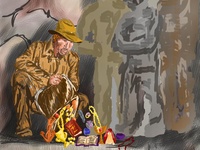Carla’s work illustrates the societal role a collection project can perform. Carla collects texts for her own research and ownership, but her collection simultaneously sheds light upon the cultural context of Cape Verdean Creole, and constructs possible paths for social development in Creole-speaking communities.
LEAR SCREEN
In the fall of 1984, the Harvard Library Bulletin published an article entitled “Prince of the Eye: Philip Hofer and the Harvard Library” written by William Bentinck-Smith. In the article, Bentinck-Smith described Philip Hofer as a “librarian, trustee, world traveler, collector and donor, founder and long curator of the College Library’s Department of Printing and Graphic Arts.”
As this lengthy list implies, Hofer was an extraordinary collector to whom Mayo attributes “revived interest in book illustration.” Hofer was not merely an extensive private collector, but he also founded the Harvard department dedicated to the preservation of printed works and illustrations.
As illustrated by Ford and Martin, the private collector is a fascinating, and often eccentric individual, one whose passion for a particular subject will take them delving through markets and auction houses, whose eye is always searching for an object of value. Their collections are highly personal and thorough and serve a higher purpose than the mere accumulation of objects: preserving material history or even aiding social advocacy.
Even so, how can the problems of private collecting be solved? The solution is in Philip Hofer’s work and in the sentiments expressed by Carla Martin. “I have already started the process of digitizing those works in [my] collection that fall under the category of public domain, and have plans to make them available on this website,” Martin wrote.
The exhibition space comes to reflect the unity of the private collection with the public space, while allowing for collections to serve a larger societal purpose. But the exhibition space is itself limited by location and access. The possibility of digitalizing collections offers permanent and limitless access to all collections, and both Martin and Houghton Library have plans to digitalize collections in the near future—Houghton intends to digitalize the pictures by Edward Lear currently being exhibited. The digital age, despite the repercussions it may have on the longevity of the material book, could render valuable artistic and historic documents freely available to all. Technology presents the possibility of further accessibility, but ultimately, the donation of private collections to public institutions allows a general public to appreciate the fruits of a collector’s passion, no matter how obscure.
—Staff writer Sarah L. Hopkinson can be reached at shopkinson@college.harvard.edu.









